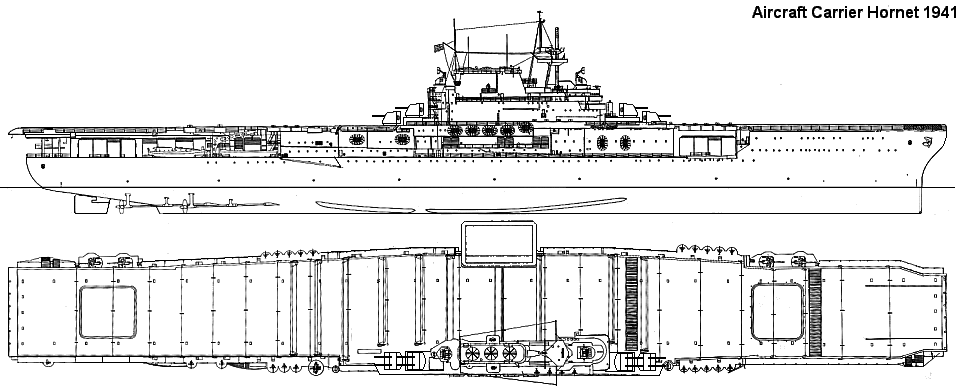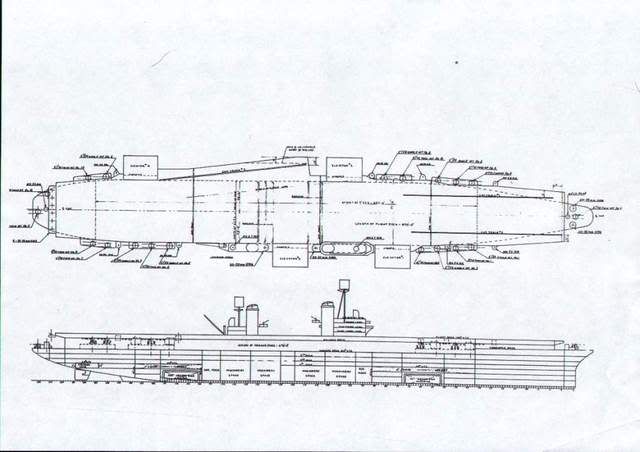The third Yorktown, to be laid down ion 1938, will have two major changes from her older sisters, 5"38 turrets on the flight deck and a deck edge elevator amidships.

USS Hornet, United States Aircraft Carrier laid down 1938
Displacement:
20,832 t light; 21,379 t standard; 23,905 t normal; 25,926 t full load
Dimensions: Length overall / water x beam x draught
811.08 ft / 770.00 ft x 83.25 ft x 26.00 ft (normal load)
247.22 m / 234.70 m x 25.37 m x 7.92 m
Armament:
8 - 5.00" / 127 mm guns (4x2 guns), 62.50lbs / 28.35kg shells, 1938 Model
Dual purpose guns in deck mounts with hoists
on side, all amidships, all raised mounts - superfiring
4 - 5.00" / 127 mm guns in single mounts, 62.50lbs / 28.35kg shells, 1938 Model
Dual purpose guns in deck mounts
on side ends, evenly spread, all raised mounts - superfiring
16 - 1.10" / 27.9 mm guns (4x4 guns), 0.67lbs / 0.30kg shells, 1938 Model
Anti-aircraft guns in deck mounts
on side, all amidships, all raised mounts - superfiring
24 - 0.30" / 7.6 mm guns (16 mounts), 0.01lbs / 0.01kg shells, 1938 Model
Machine guns in deck mounts
on side, evenly spread, all raised mounts
Weight of broadside 761 lbs / 345 kg
Shells per gun, main battery: 150
Armour:
- Belts: Width (max) Length (avg) Height (avg)
Main: 4.00" / 102 mm 476.78 ft / 145.32 m 10.95 ft / 3.34 m
Ends: Unarmoured
Main Belt covers 95 % of normal length
- Torpedo Bulkhead:
2.00" / 51 mm 476.78 ft / 145.32 m 22.93 ft / 6.99 m
- Gun armour: Face (max) Other gunhouse (avg) Barbette/hoist (max)
Main: 2.00" / 51 mm 1.00" / 25 mm 2.00" / 51 mm
- Armour deck: 2.50" / 64 mm, Conning tower: 4.00" / 102 mm
Machinery:
Oil fired boilers, steam turbines,
Geared drive, 4 shafts, 118,213 shp / 88,187 Kw = 31.10 kts
Range 12,500nm at 15.00 kts
Bunker at max displacement = 4,547 tons
Complement:
960 - 1,249
Cost:
£7.114 million / $28.457 million
Distribution of weights at normal displacement:
Armament: 95 tons, 0.4 %
Armour: 3,783 tons, 15.8 %
- Belts: 882 tons, 3.7 %
- Torpedo bulkhead: 809 tons, 3.4 %
- Armament: 41 tons, 0.2 %
- Armour Deck: 1,979 tons, 8.3 %
- Conning Tower: 72 tons, 0.3 %
Machinery: 3,237 tons, 13.5 %
Hull, fittings & equipment: 8,467 tons, 35.4 %
Fuel, ammunition & stores: 3,073 tons, 12.9 %
Miscellaneous weights: 5,250 tons, 22.0 %
Overall survivability and seakeeping ability:
Survivability (Non-critical penetrating hits needed to sink ship):
44,310 lbs / 20,099 Kg = 709.0 x 5.0 " / 127 mm shells or 6.1 torpedoes
Stability (Unstable if below 1.00): 1.11
Metacentric height 4.7 ft / 1.4 m
Roll period: 16.2 seconds
Steadiness - As gun platform (Average = 50 %): 80 %
- Recoil effect (Restricted arc if above 1.00): 0.11
Seaboat quality (Average = 1.00): 2.00
Hull form characteristics:
Hull has raised forecastle
Block coefficient: 0.502
Length to Beam Ratio: 9.25 : 1
'Natural speed' for length: 27.75 kts
Power going to wave formation at top speed: 49 %
Trim (Max stability = 0, Max steadiness = 100): 40
Bow angle (Positive = bow angles forward): 27.00 degrees
Stern overhang: 21.00 ft / 6.40 m
Freeboard (% = measuring location as a percentage of overall length):
- Stem: 39.40 ft / 12.01 m
- Forecastle (19 %): 39.40 ft / 12.01 m (29.75 ft / 9.07 m aft of break)
- Mid (50 %): 29.75 ft / 9.07 m
- Quarterdeck (19 %): 29.75 ft / 9.07 m
- Stern: 29.75 ft / 9.07 m
- Average freeboard: 31.59 ft / 9.63 m
Ship space, strength and comments:
Space - Hull below water (magazines/engines, low = better): 94.4 %
- Above water (accommodation/working, high = better): 252.6 %
Waterplane Area: 42,788 Square feet or 3,975 Square metres
Displacement factor (Displacement / loading): 147 %
Structure weight / hull surface area: 115 lbs/sq ft or 563 Kg/sq metre
Hull strength (Relative):
- Cross-sectional: 0.93
- Longitudinal: 1.93
- Overall: 1.00
Hull space for machinery, storage, compartmentation is adequate
Room for accommodation and workspaces is excellent
Ship has slow, easy roll, a good, steady gun platform
Excellent seaboat, comfortable, can fire her guns in the heaviest weather
72 Aircraft as built


